The Parkmaker's Guide:
Duelers for the Intermediate
Well done. You've mastered the beginner's course (Issue #2) and now you're ready to move on to better dueling capabilities. Did you have fun experimenting with turns and drops? Good, because now we're going to get into more difficult matters.
Crosses
Turns and drops are fun with duelers, but one can only go so far with them. You probably want a more thrilling ride that's impressive and still synchronized. If that's the case, then you're going to need to learn how to do crosses.
Crosses are sections of the tracks where the two trains head into a collision course with each other, then cruise on by safe and sound. Notice the picture below. What's the difference between the blue track and the red track? I can tell you right now. The two tracks are identical except for ONE difference. I've inserted an extra piece of straight track with the blue Virginia Reel. Why did I have to do that? Because if I hadn't, the blue track would've been too short to reach past the red track. Therefore, the blue track and red track would've gotten in each other's way and crashed.
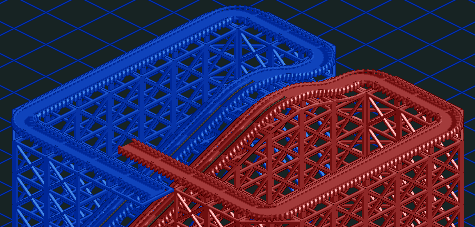
But you're probably thinking back to the first dueler's guide when I said that both coasters should have an even amount of track pieces. Well, that's not necessarily true. Because the one straight track is short, it doesn't make enough of a difference to throw the two trains out of balance. In other words, a couple little abnormalities here or there isn't going to hurt. Try making a dueler similar to this one. You might ask me, "What am I supposed to do next?" That's simple.
Since the blue track already has one more straight track than the red, try dipping the coasters, turning them around, then crossing them again. Crazy, isn't it? But it makes for a very good ride. The only thing you have to remember is that they must have equal track pieces from here on so that they keep on the same course and speed. This what I did to my two coasters.
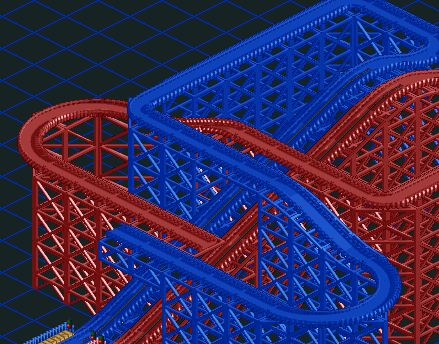
Notice how both tracks have the same slope and the same wide turn with the same amount of track pieces. This is important so that they can continue to almost hit each other. Do this as many times as you like, and feel free to try different roller coaster types than just a Virginia Reel. Other good suggestions for these type of duelers are the wild mouse type.
Ending the coaster isn't all that tricky either. Most people keep criss crossing until they reach the very end, but remember that extra track that the blue coaster had? In order to balance it out, red will have to have some extra room, and try experimenting with different ways to get both tracks back to the station. You want them to be as even as possible, but don't kill yourself if they're not perfect.
There's just one problem. If you copied my design exactly, you'll notice that they don't criss cross where they should. They're a touch off balanced and it looks rather funny. The reason they're not fully synchronized is that extra piece of track blue has. To be honest, I stuck it in a very bad spot - where the two trains are the slowest. If you want the smallest difference in time between the two coasters, make sure that the trains are going fast. The faster they are, the less difference you'll see in synchronization.
Now that you've learned the basics for the crosses, you're ready to build some fun stuff. All of the following are what I call "Crossover Elements." Sure, I may not know the proper name for all of these, but I've tried my best and I explain all of them in detail. Observe carefully.
Cross the Loops
This little showcase is great for the beginning of a coaster, but can still be placed just about anywhere as long as both trains are still synchronized. It ties together the cross with the loop, and makes for a nice display. If you noticed, these tracks are also identical EXCEPT for one more straight piece in blue's track. Simple to do, and very impressive. Also works with wooden coasters as well (but it looks a little funny).
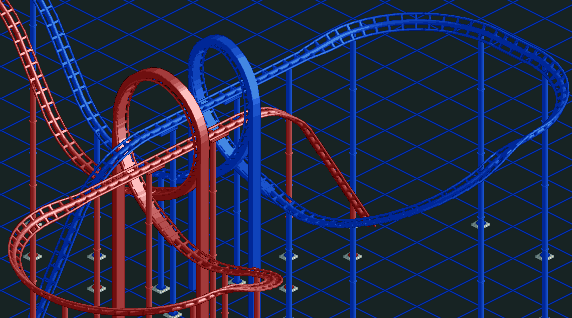
Barrel Roll Loops
For all of you B&M fans out there, this one's definitely fun to do. It involves the same basic concept of the previous version, only a little backwards. This time, I've inserted an extra piece of track for the red coaster, and that's a must unless you want the two tracks to bump into each other.
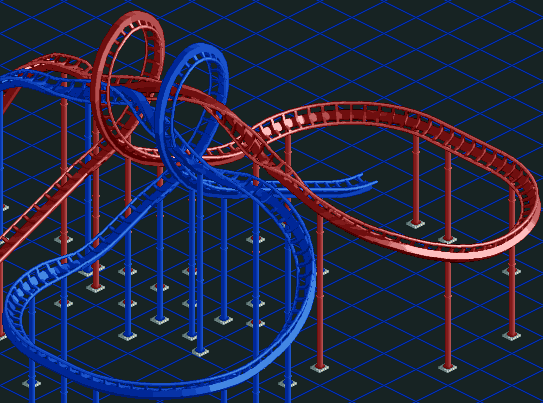
Station Loops
As long as we're talking loops, I might as well demonstrate the easiest one to do. You don't need to insert any extra tracks in either of your coasters. This one simply requires an obstacle to loop, and I've always found it fun to choose the station. But always make sure that the two trains are still synchronized before they run through this, otherwise they won't loop at the same time (which really diminishes the effect).
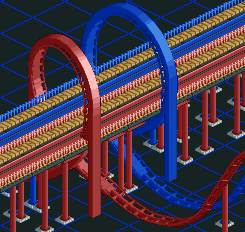
Interlocking Corkscrews
This one is very simple to do and it's a dazzle to look at. Simply set it up how you'd like so that they have enough momentum to complete the corkscrew and so they're still side by side synchronized. Then, add one extra piece of straight track to Coaster A, create your two corkscrews, add an extra piece of straight track to Coaster B, and continue on your way.
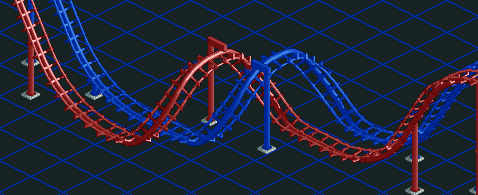
Interlocking Cobra Rolls
This one still involves corkscrews on top of each other, but this time in a different manner. Below, the two tracks are identical except one of them is set farther back than the other (1 tile, to be specific). This is a good choice if one of your coasters is travelling farther ahead or faster than the other. It gives the other one a chance to catch up.
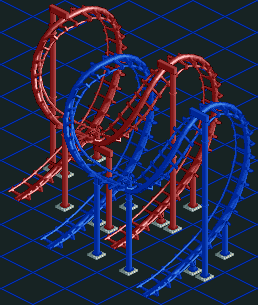
Interlocking Hills
You won't find this often in many coasters, but I like how they look so I'm including them anyways. It's also nice because both coasters have the exact same amount of track pieces when finished, so it doesn't throw your duelers off balance too much. Try it out and observe for yourself.
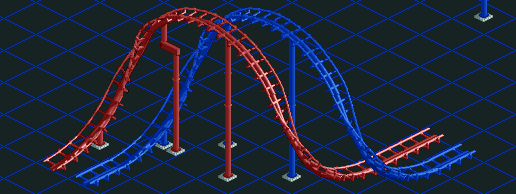
Well, don't just sit there. Get up and ... well, sit there. But open that RCT on your computer and begin building duelers again! Try some of the easy elements I showed you, mixed with some hills and turns from the first tutorial, add some crosses, and you'll have the best time building these wonderful works of moving art. Good luck and don't be afraid to experiment!
Copyright © Steve Welch